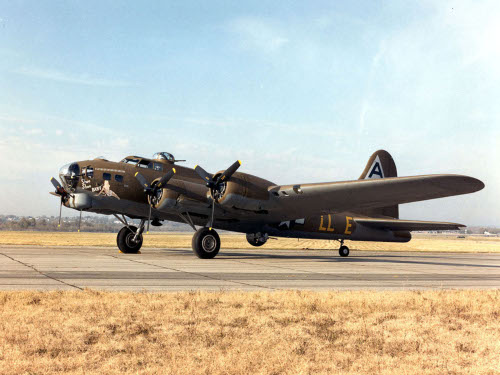![]() The Pacific War Online Encyclopedia
The Pacific War Online Encyclopedia
|
| Previous: Heath, Lewis | Table of Contents | Next: Heavy Cruisers (CA) |

This is a type of aircraft specifically optimized to carry large bomb loads for long distances, with no allowance for high maneuverability or low level attack. In the pre-WWII era this could include planes with as few as two engines, but generally aircraft in this category had four or more engines. Examples of heavy bombers include the B-17 Flying Fortress or the British Lancaster.
Neither Japan nor Germany produced true heavy bombers. For the Germans this resulted from the belief that dive bombers like the Ju-87 and medium bombers like the He-111 would suffice for the delivery of high explosives to land targets. In Japan, the belief that the next war would be a short and violent affair led to a concentration of effort on destroying military targets, and the weapons provided were optimized for that role. Furthermore, likely industrial targets were not readily accessible, and seriously damaging them would take too long in the context of a short war, which reduced the interest in strategic bombing.
Heavy bombers could carry a wide range of ordnance, from the standard load of 500 pound bombs to very large single weapons like the 12,000 pound "Tallboy" or the 22,000 pound "Grand Slam" bomb. Other weapons would include everything from small incendiaries to the first nuclear weapons. Depending on what weapons were carried, and where they were carried, the range of the aircraft could vary greatly. Extra underwing racks could be carried on certain models to increase the bomb load for short distances, while for the single large bombs the bomb bay doors might have to be removed to allow the bomb to fit.
The targets of the heavy bomber were, in general, targets of
industry. While they could be used for tactical purposes, either in
support of a special military operation (like bombing the airfields
that kamikazes
took off from during the Okinawa
campaign) or against a special target (like the German battleship Tirpitz), for day
to day use they attacked industrial targets. Due to the inaccuracy of
the bombing, this slowly metamorphosed into a campaign against cities,
based on the logic that if attacking a factory that manufactured tanks was allowed, then
attacking the workers who worked in the factory was also allowed.
Wartime experience showed that heavy bombers were useless for attacking
ships in motion,
but they could make a real mess of a stationary target. An
unanticipated
target for heavy bombers were merchant ships, but not in a traditional
bombing attack approach. Instead,
B-29s
were used to lay large minefields
in Japanese coastal waters. While the USAAF was initially very
resistant to this approach, once the success of the operations was
apparent, these
missions became more popular.
Bombing accuracy fell far short of optimistic prewar estimates. Even
the American Norden bomb
sight, which used an electromechanical analog
computer to determine the exact moment of bomb release, was lucky to
put 5% of the bombs within 50 feet of the target under ideal conditions.
To counter the heavy bombers, systems of detection stations, fighter strips and antiaircraft gun emplacements were developed. Detection stations had to detect the approaching formation from as far out as possible to allow the defending fighters time to get to the necessary altitude to attack the bombers. Ideally the fighters would try to get above the bombers so they had an advantage in being able to dive on their targets. The other threat to heavy bombers were antiaircraft guns. The antiaircraft guns had to be very powerful to send large shells to the high altitudes of the bombers as quickly as possible. Large shells were needed to create bursts of flak to damage nearby aircraft, and a short travel time time was required because, once the gun fired, the shell's path was fixed, while the plane could continue to maneuver.
To counter this, heavy bombers were fitted with larger numbers of more effective defensive weapons. Armor was fitted over critical areas to improve survivability. Attempts had been made to build an "escort" heavy bomber (the YB-40) that carried powerful defensive armament to fight off enemy fighters in place of a bomb load, but it did not turn out to be terribly effective. But the primary way of dealing with enemy fighters was to ensure that friendly fighters could accompany the bombers and provide protection, and the primary way of dealing with the antiaircraft guns was to fly higher - which lead to the development of pressurized flight-decks.
While the dictum "the bomber will always get through" appeared
to be true, judging from the results of the war, the reality was that
this required frequent updates in terms of speed, weaponry, altitude
and in supporting technology (escort fighters, radar jamming, etc)
and, despite these steps to increase their survivability, a large
percentage did not return from their missions.
The Pacific War Online
Encyclopedia. This article © 2007 by John E. Kollar. Index